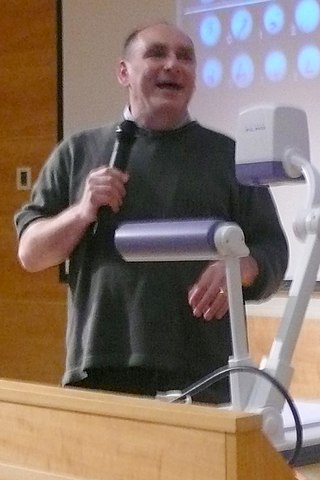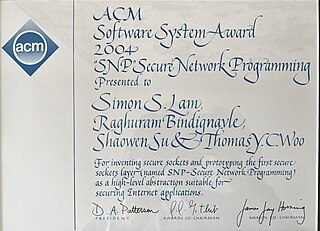In computing, Internet Protocol Security (IPsec) is a secure network protocol suite that authenticates and encrypts packets of data to provide secure encrypted communication between two computers over an Internet Protocol network. It is used in virtual private networks (VPNs).

Robert Elliot Kahn is an American electrical engineer who, along with Vint Cerf, first proposed the Transmission Control Protocol (TCP) and the Internet Protocol (IP), the fundamental communication protocols at the heart of the Internet.

Van Jacobson is an American computer scientist, renowned for his work on TCP/IP network performance and scaling. He is one of the primary contributors to the TCP/IP protocol stack—the technological foundation of today’s Internet. Since 2013, Jacobson is an adjunct professor at the University of California, Los Angeles (UCLA) working on Named Data Networking.

Louis Pouzin is a French computer scientist. He designed a pioneering packet communications network, CYCLADES that was the first to implement the end-to-end principle, which became fundamental to the design of the Internet.
A middlebox is a computer networking device that transforms, inspects, filters, and manipulates traffic for purposes other than packet forwarding. Examples of middleboxes include firewalls, network address translators (NATs), load balancers, and deep packet inspection (DPI) devices.

Radia Joy Perlman is an American computer programmer and network engineer. She is a major figure in assembling the networks and technology to enable what we now know as the internet. She is most famous for her invention of the Spanning Tree Protocol (STP), which is fundamental to the operation of network bridges, while working for Digital Equipment Corporation, thus earning her nickname "Mother of the Internet". Her innovations have made a huge impact on how networks self-organize and move data. She also made large contributions to many other areas of network design and standardization: for example, enabling today's link-state routing protocols, to be more robust, scalable, and easy to manage.
A network socket is a software structure within a network node of a computer network that serves as an endpoint for sending and receiving data across the network. The structure and properties of a socket are defined by an application programming interface (API) for the networking architecture. Sockets are created only during the lifetime of a process of an application running in the node.
George Varghese is a Principal Researcher at Microsoft Research. Before joining MSR's lab in Silicon Valley in 2013, he was a Professor of Computer Science at the University of California San Diego, where he led the Internet Algorithms Lab and also worked with the Center for Network Systems and the Center for Internet Epidemiology. He is the author of the textbook Network Algorithmics, published by Morgan Kaufmann in 2004.
The Skype protocol is a proprietary Internet telephony network used by Skype. The protocol's specifications have not been made publicly available by Skype and official applications using the protocol are closed-source.
Randy Howard Katz is a distinguished professor emeritus at University of California, Berkeley of the electrical engineering and computer science department.

Douglas Earl Comer is a professor of computer science at Purdue University, where he teaches courses on operating systems and computer networks. He has written numerous research papers and textbooks, and currently heads several networking research projects. He has been involved in TCP/IP and internetworking since the late 1970s, and is an internationally recognized authority. He designed and implemented X25NET and Cypress networks, and the Xinu operating system. He is director of the Internetworking Research Group at Purdue, editor of Software - Practice and Experience, and a former member of the Internet Architecture Board. Comer completed the original version of Xinu in 1979. Since then, Xinu has been expanded and ported to a wide variety of platforms, including: IBM PC, Macintosh, Digital Equipment Corporation VAX and DECstation 3100, Sun Microsystems Sun-2, Sun-3 and SPARCstations, and Intel Pentium. It has been used as the basis for many research projects. Furthermore, Xinu has been used as an embedded system in products by companies such as Motorola, Mitsubishi, Hewlett-Packard, and Lexmark.

Alexander G. Fraser, also known as A. G. Fraser and Sandy Fraser, was a noted British-American computer scientist.

Jonathan Andrew Crowcroft is the Marconi Professor of Communications Systems in the Department of Computer Science and Technology, University of Cambridge, a Visiting Professor at the Department of Computing at Imperial College London, and the chair of the programme committee at the Alan Turing Institute.
In computing, a firewall is a network security system that monitors and controls incoming and outgoing network traffic based on predetermined security rules. A firewall typically establishes a barrier between a trusted network and an untrusted network, such as the Internet.
Hari Balakrishnan is the Fujitsu Professor of Computer Science and Artificial Intelligence in the Department of Electrical Engineering and Computer Science at MIT, and the Co-founder and CTO at Cambridge Mobile Telematics.
Multipath TCP (MPTCP) is an ongoing effort of the Internet Engineering Task Force's (IETF) Multipath TCP working group, that aims at allowing a Transmission Control Protocol (TCP) connection to use multiple paths to maximize throughput and increase redundancy.

RIOT is a small operating system for networked, memory-constrained systems with a focus on low-power wireless Internet of things (IoT) devices. It is open-source software, released under the GNU Lesser General Public License (LGPL).

Secure Network Programming (SNP) is a prototype of the first Secure Sockets Layer, designed and built in 1993 by the Networking Research Laboratory at the University of Texas at Austin, led by Simon S. Lam. This work was published in the 1994 USENIX Summer Technical Conference. For this project, the authors won the 2004 ACM Software System Award.

Zygmunt J. Haas is a professor and distinguished chair in computer science, University of Texas at Dallas (UTD) also the professor emeritus in electrical and computer engineering, Cornell University. His research interests include ad hoc networks, wireless networks, sensor networks, and zone routing protocols.











